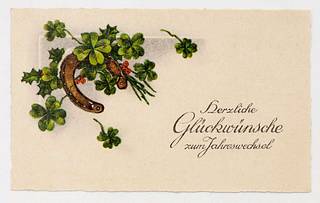
Similar
Feldpost von Hans 1944-12-29 5 - Public domain postcard scan
Summary
Deutsch: Feldpostbriefe von Hans Koch, Wien, 2. Weltkrieg, Ostfront, 1922-1945
vorheriger Brief (1944-12-19)
Brief Nr. 301 (1944-12-29)
nächster Brief (1945-01-04)
Briefumschlag:
Vorderseite
Rückseite
Brief:
Seite 1
Seite 2
Karte - Vorderseite
Karte - Rückseite
TEXT
(Farb-Zeichnung: vieblättriger Kleeblätter und Hufeisen als Glücksbringer)
Herzliche Glückwünsche zum Jahreswechsel
This is an attempt to see World War 2 through the eyes of people who lived or fought on the territories controlled by the Axis powers, originally the Rome–Berlin Axis. Axis' principal members in Europe were Nazi Germany, the Kingdom of Italy, Hungary, and Spain. During World War II, Nazi Germany and Axis powers occupied or controlled a number of countries in Europe and beyond. At its zenith in 1942, the Axis presided over large parts of Europe, North Africa, and East Asia, either through occupation, annexation, or puppet states. The collection is made with an image recognition aid, so a small percentage of images may be wrongly attributed as European & 1939-1945. Here is a list of some of the countries that were occupied or allied with Nazi Germany during the war: Austria: Nazi Germany annexed Austria in 1938, after the Anschluss, which was the union of Austria and Germany. Czechoslovakia: Nazi Germany occupied the western and southern regions of Czechoslovakia in 1938, after the Munich Agreement. The rest of the country was occupied in 1939, after the invasion of Poland. Denmark: Nazi Germany occupied Denmark in 1940, after the invasion of Norway. France: Nazi Germany occupied France in 1940, after the fall of Paris. The French government set up a collaborationist regime in the unoccupied zone of Vichy. Greece: Nazi Germany invaded and occupied Greece in 1941, after the fall of Crete. Italy: Italy was an ally of Nazi Germany during World War II, but was also occupied by German forces after the fall of Mussolini in 1943. Netherlands: Nazi Germany occupied the Netherlands in 1940, after the invasion of Belgium. Norway: Nazi Germany invaded and occupied Norway in 1940. Poland: Nazi Germany invaded and occupied Poland in 1939, at the start of World War II. Belgium: Nazi Germany occupied Belgium in 1940, after the invasion of the Netherlands. Luxembourg: Nazi Germany occupied Luxembourg in 1940, after the invasion of Belgium. Ukraine: Nazi Germany occupied parts of Ukraine during World War II, after the invasion of the Soviet Union in 1941. Belarus: Nazi Germany occupied Belarus during World War II, after the invasion of the Soviet Union in 1941. Russia: Nazi Germany invaded and occupied parts of the Soviet Union during World War II, after the invasion in 1941. Yugoslavia: Nazi Germany occupied parts of Yugoslavia during World War II, after the invasion in 1941. Albania: Nazi Germany occupied Albania in 1943, after the fall of Mussolini. Hungary: Hungary was an ally of Nazi Germany during World War II, but was also occupied by German forces after the fall of the Hungarian government in 1944. Romania: Romania was an ally of Nazi Germany during World War II, but was also occupied by German forces after the fall of the Romanian government in 1944. Bulgaria: Bulgaria was an ally of Nazi Germany during World War II, but was also occupied by German forces after the fall of the Bulgarian government in 1944. Finland: Finland was an ally of Nazi Germany during World War II, but was not occupied by German forces.
New Year's celebrations have a long history dating back to ancient civilizations. The earliest recorded New Year's celebration is believed to have been held by the ancient Babylonians around 2000 BCE. They held a celebration called Akitu, which lasted for 11 days and marked the beginning of the new year, the return of the goddess Ishtar, and the re-creation of the world. The ancient Romans also celebrated the new year, although their calendar was different from the one we use today. The Roman calendar originally began on March 1, and the new year was celebrated on the vernal equinox, which is the first day of spring. The Roman calendar was later changed by Julius Caesar to begin on January 1, and this change was eventually adopted by most Western civilizations. New Year's celebrations have been held on January 1 in many cultures around the world, including in Western Europe, the Americas, and Asia. In many cultures, New Year's is a time for people to reflect on the past year and make resolutions for the new year. It is also a time for celebration, with parties, fireworks, and other festive events. In modern times, New Year's celebrations continue to be a popular way to mark the start of a new year and to look forward to the future with hope and optimism. While both Christmas and New Year holidays are times for celebration, they have different origins and traditions. New Year's Day is a secular holiday that is celebrated around the world, while Christmas is a religious holiday that is primarily celebrated by Christians.
Tags
Date
Source
Copyright info
























